
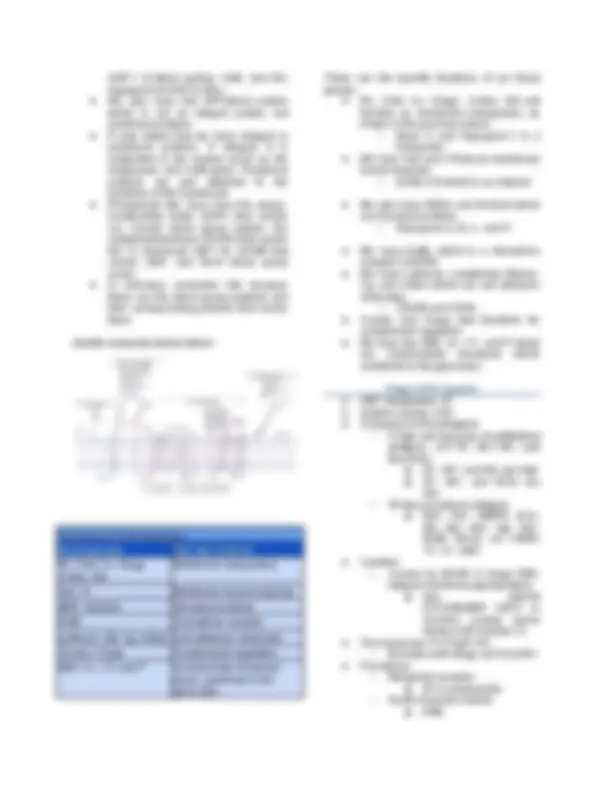
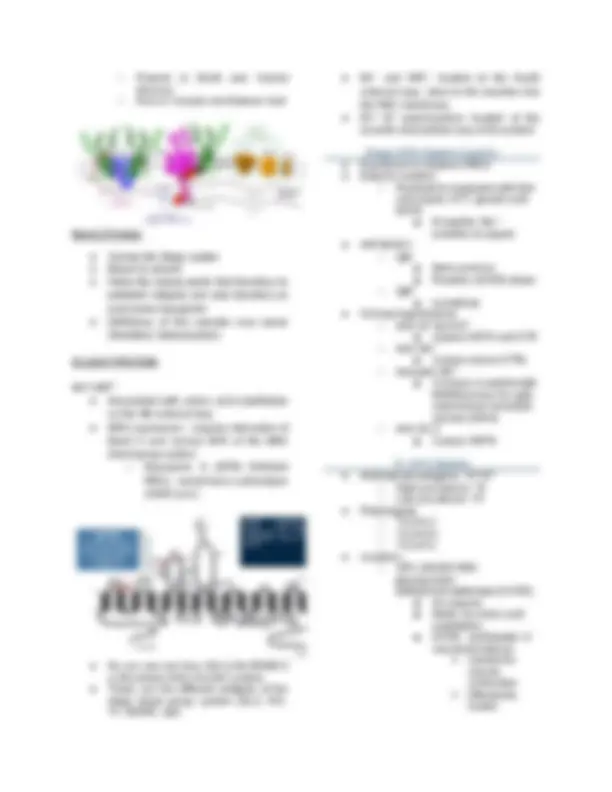
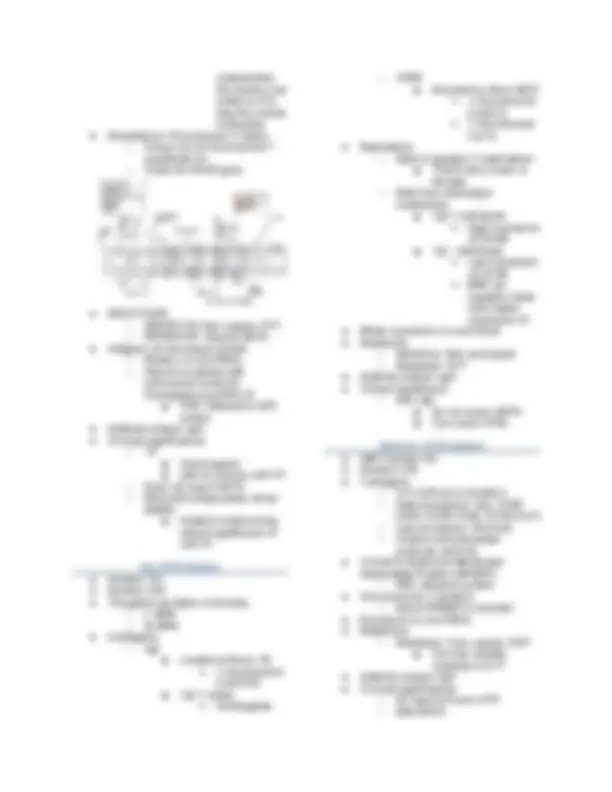
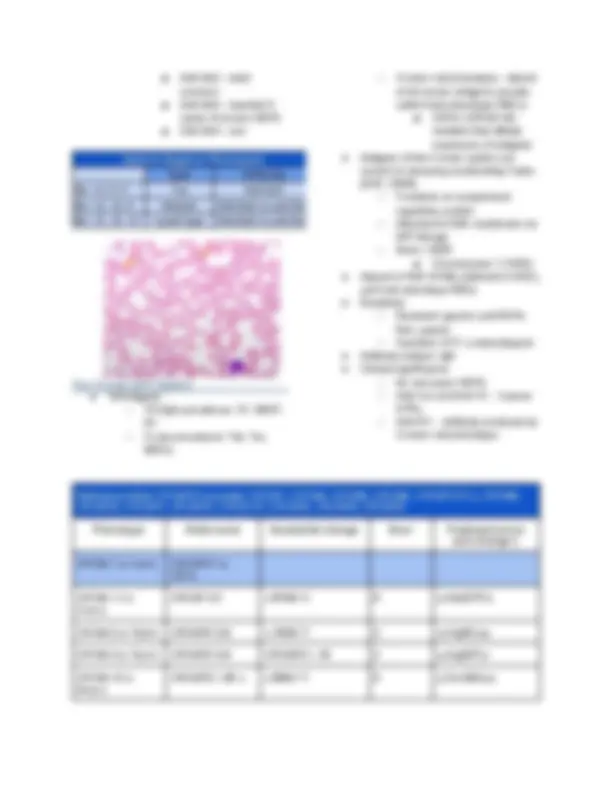
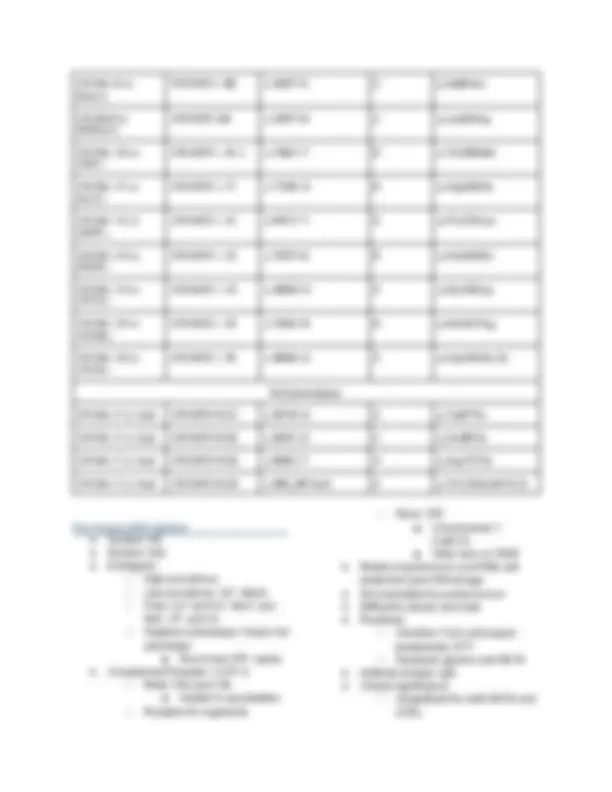
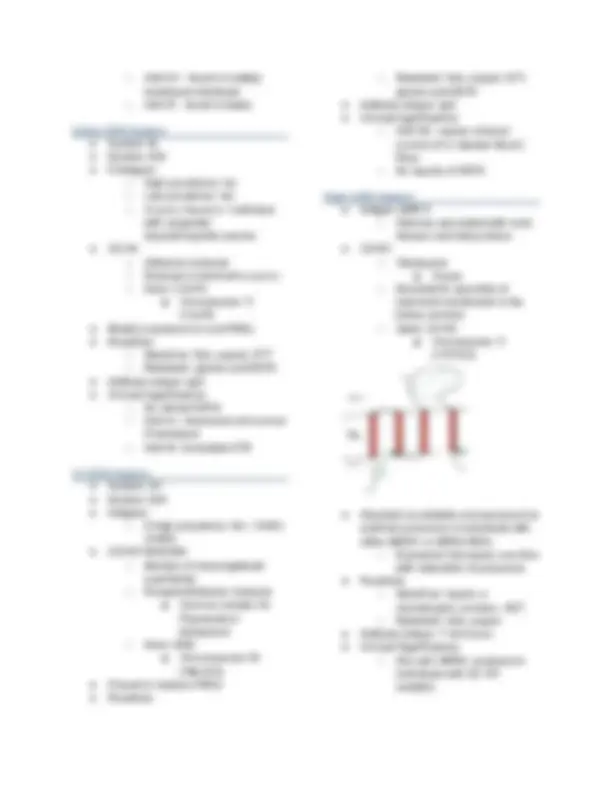
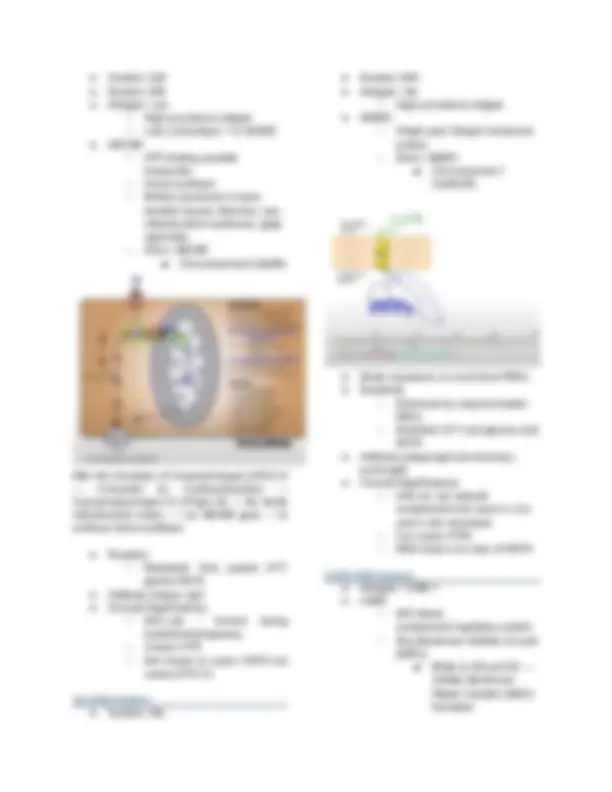
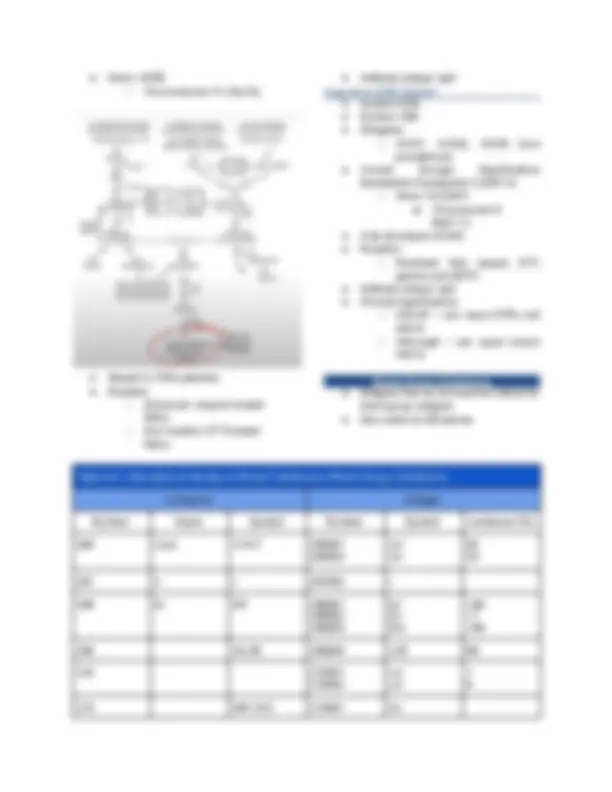
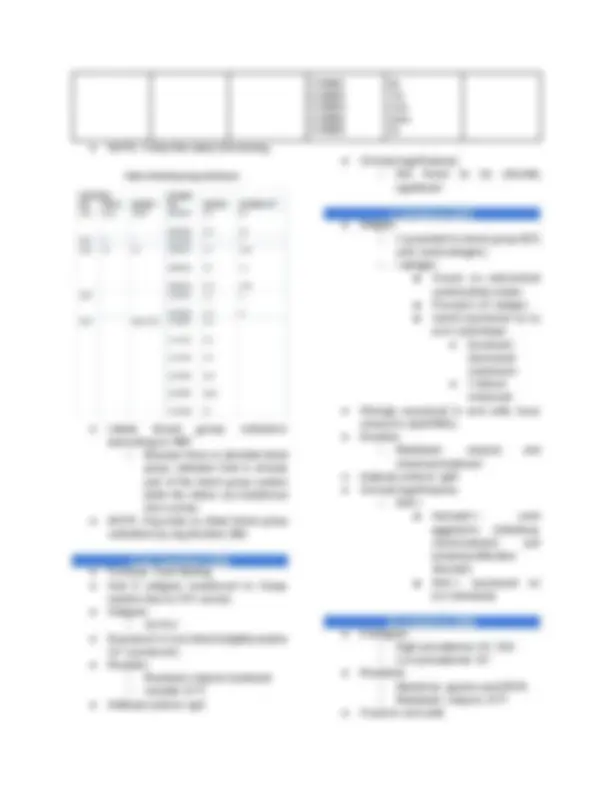
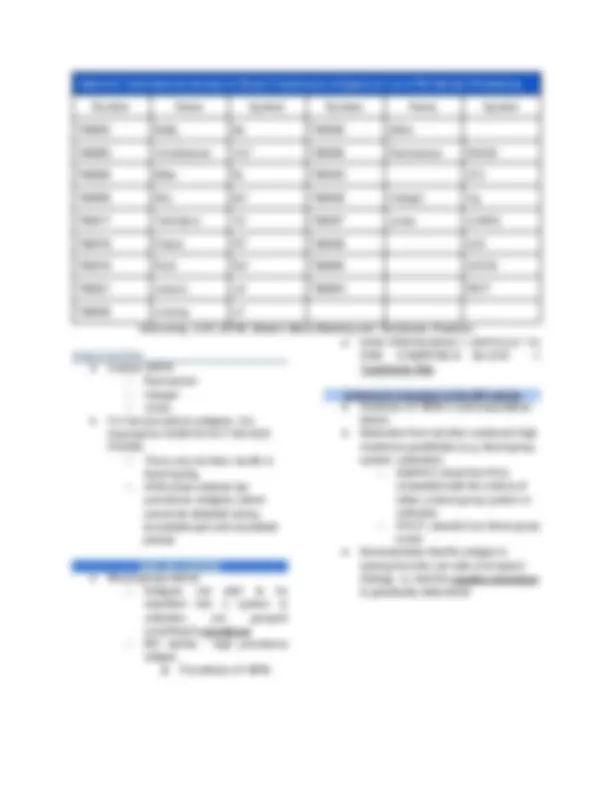
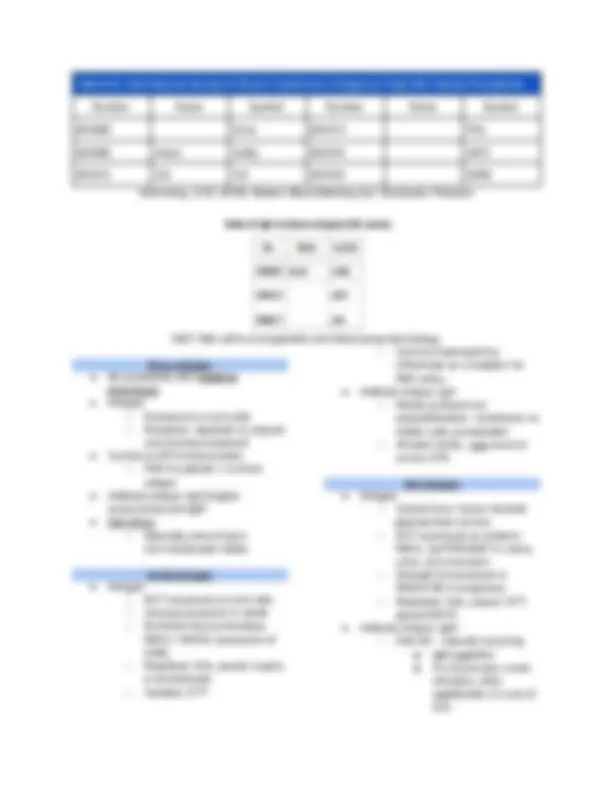
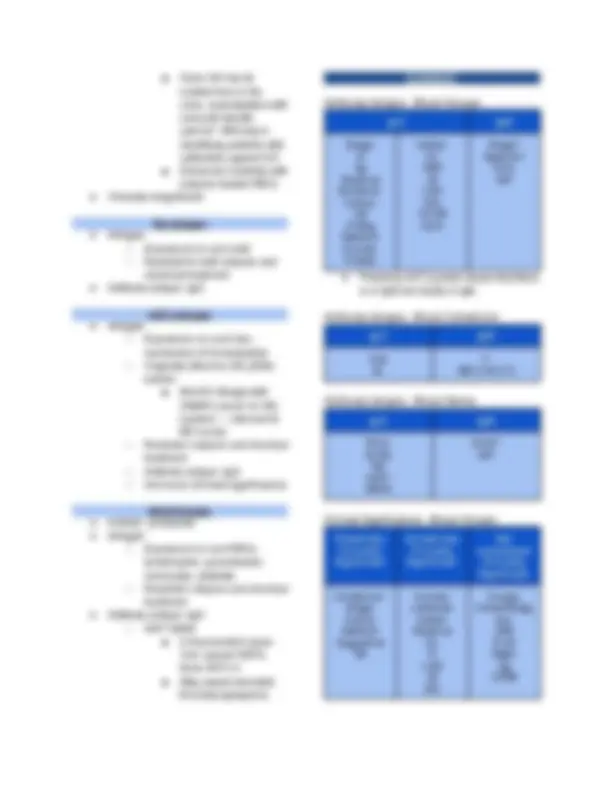
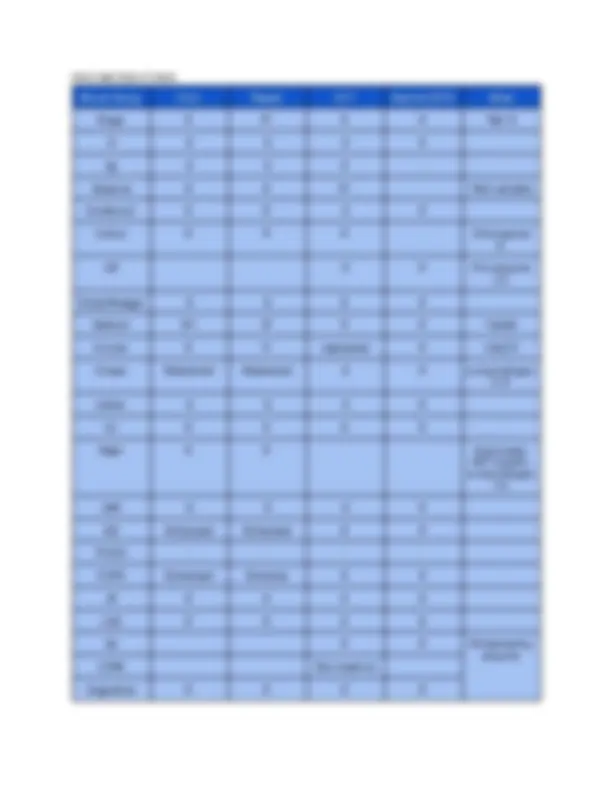
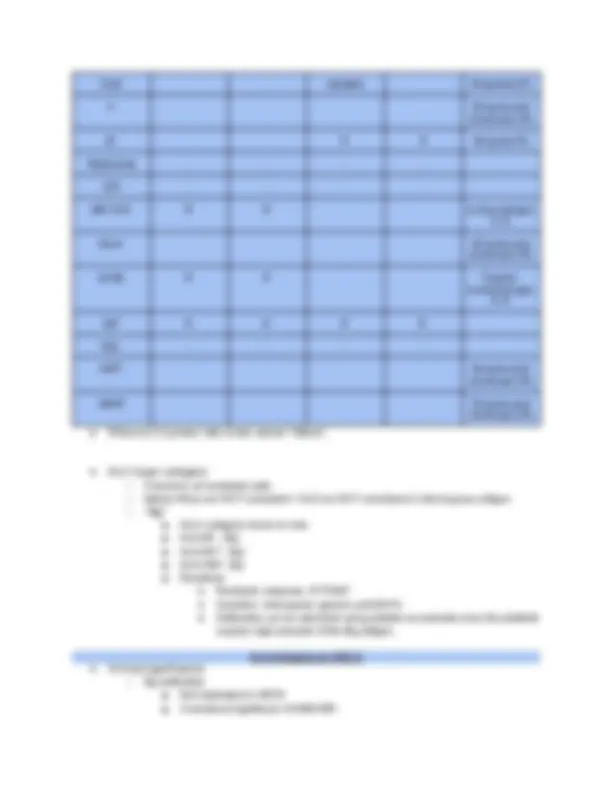
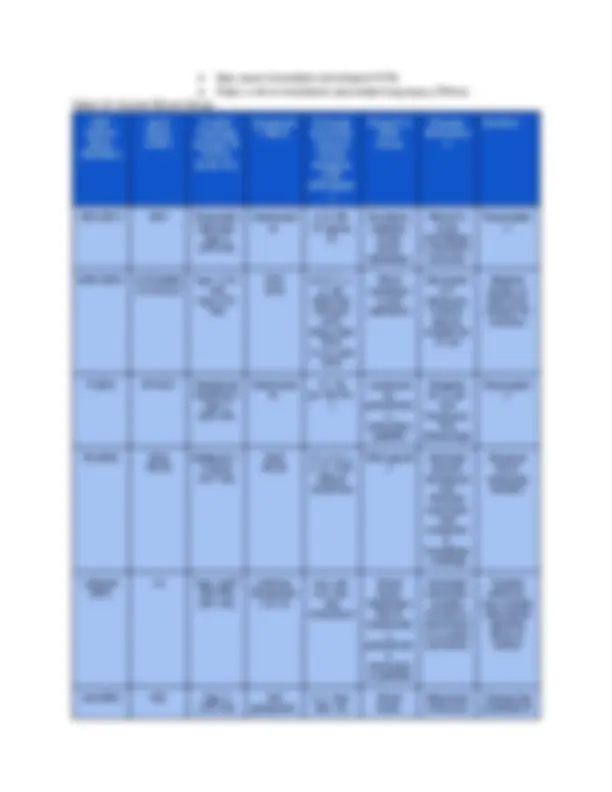
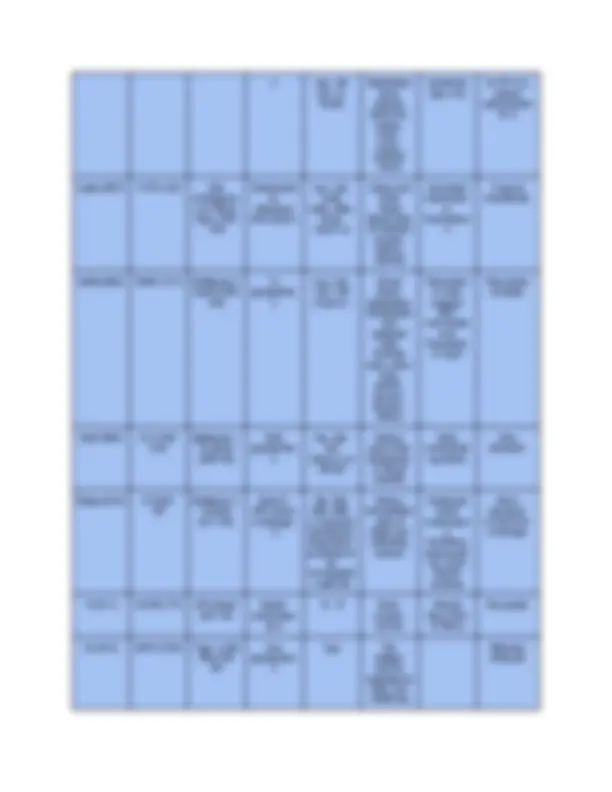
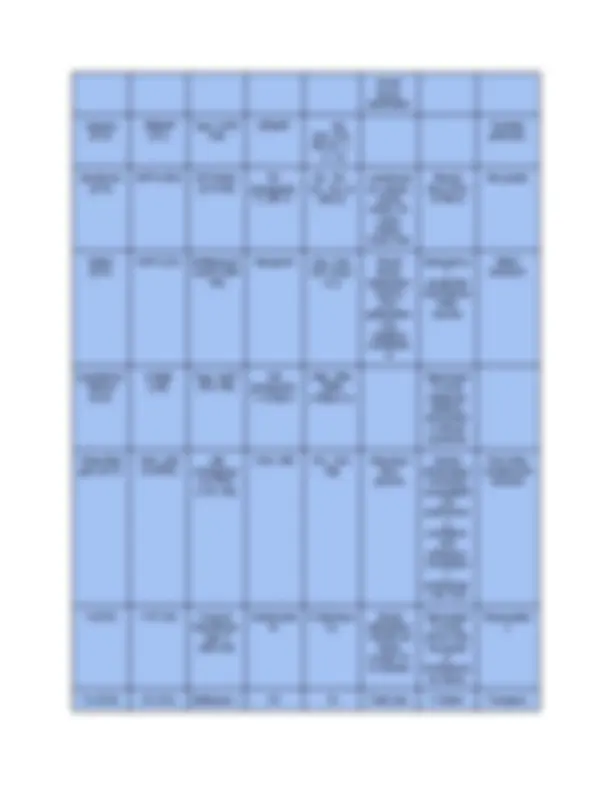
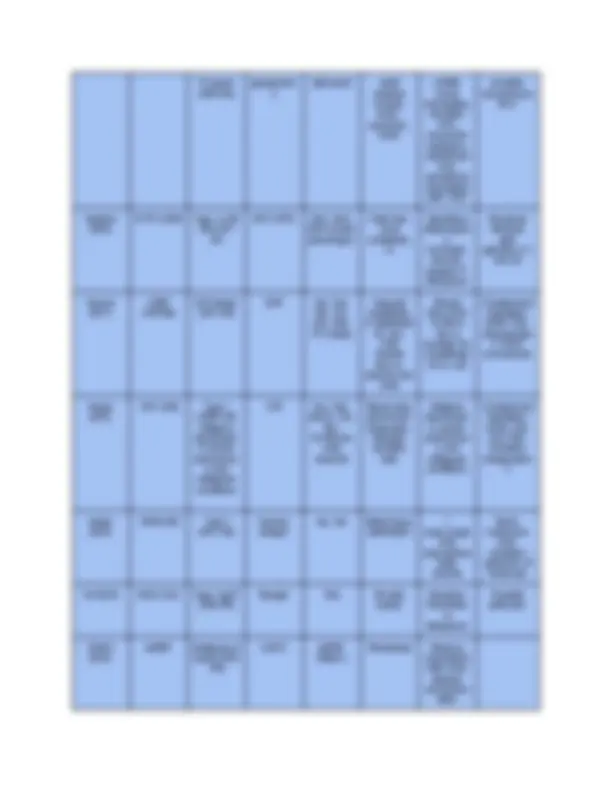
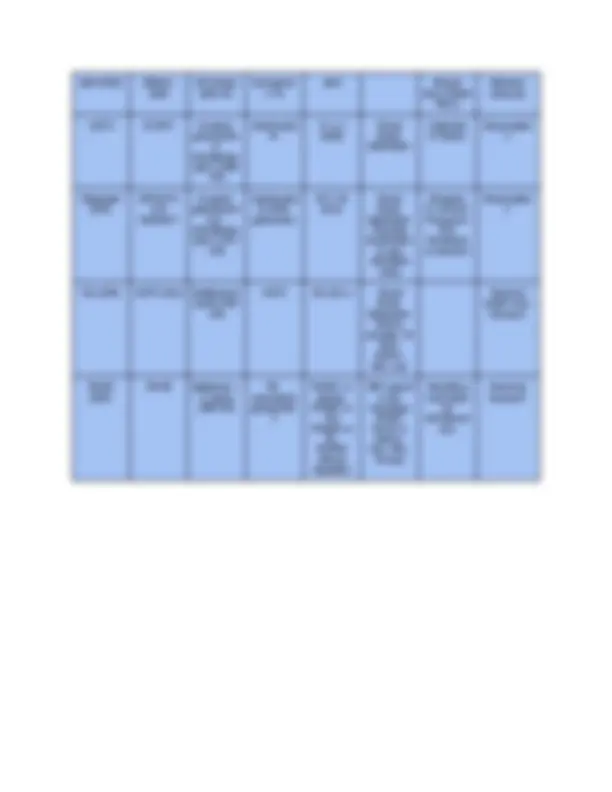


Study with the several resources on Docsity

Earn points by helping other students or get them with a premium plan


Prepare for your exams
Study with the several resources on Docsity

Earn points to download
Earn points by helping other students or get them with a premium plan
Community
Ask the community for help and clear up your study doubts
Discover the best universities in your country according to Docsity users
Free resources
Download our free guides on studying techniques, anxiety management strategies, and thesis advice from Docsity tutors
As you explore this enchanting collection, you're not just acquiring a captivating display; you're connecting to the brilliance of Prof. Jennie Ong. Her knowledge and passion for immunohematology are embedded in each detail, offering you an immersive journey into the world of Rh antigens.
Typology: Study notes
1 / 27

This page cannot be seen from the preview
Don't miss anything!




















Terminologies ● Blood Group System ○ Consists of one or more antigens controlled at a single gene locus, or by two or more very closely linked homologous genes with little or no observable recombination between them. ● ISBT Blood Group Collection ○ Antigens that have biochemical, serologic, or genetic relationship but do not meet the criteria for a system ● I SBT Series ○ Antigens not able to be classified into a system or collection are grouped according to prevalence ■ 700 series – low prevalence antigen - prevalence of less than 1% ■ 901 series – high-prevalence antigenprevalence of > 90% Criteria for the establishment of new blood group systems: According to ISBT: ● The antigen must be defined by a human alloantibody ○ A person should have already produced an antibody against these specific blood group ● The antigen must be an inherited character ○ Transfer to offspring ○ Acquired or inherited from the parents ● The gene encoding it must have been identified and sequenced ○ Meaning, it is already determined on what chromosome, gene, and locus it can found ● Its chromosomal location must be known ○ Basically the location in the locus. ○ p - short arm ○ q - long arm ○ Example: Ch6p ○ Specific location should be identified ● The gene must be different from, and not a closely linked homologue of, all other genes encoding antigens of existing blood group systems. Criteria for the inclusion of a new specificity in an established system: ● An antithetical relationship between a new antigen and one already assigned to the system. ○ For example, in an ABO blood group, a new antigen is discovered, L antigen, what is the criteria that will allow the L antigen to become a part of the ABO blood group system? ○ Thus, criteria is needed for the newly discovered antigen to be part of a blood group system ● Demonstration that expression of the antigen is associated with a variation in the nucleotide sequence of the gene controlling the system ○ So, for example, chromosome 7 is the one that controls the gene, meaning the L antigen should also be coded by chromosome 7 in that specific location – Chromosome 7p13. Hence, L should also be a part of the chromosome. ● Evidence, from a linkage analysis of family data, that the controlling allele is probably a newly recognized form of the pertinent gene, and supporting serological or biochemical information. ● Demonstration that an antigen is located on a protein or glycoprotein that carries other antigens belonging to the system. It must be remembered, however, that this could result from post-translational modification of a gene product, such as glycosylation, which would not support inclusion within the system. BLOOD GROUP SYSTEMS ● Old table only shows 29 blood group systems ● Harmening already listed up to 36.
Table I. Other Blood Group System ISBT No. Blood group system name Chromoso me Location 010 Diego 17 011 Yt 7 012 Xg X 013 Scianna 1 014 Dombrock 12 015 Colton 7 016 Lansteiner- Weiner 19 017 Chido-Rogers 19 018 H 19 019 Kx X 020 Gerbich 2 021 Cromer 1 022 Knops 1 023 Indian 11 024 Ok 19 025 Ralph 11 026 John Milton Hagan 15 027 I 6 028 Globoside 3 029 Gill 9 030 Rh-associated glycoprotein
034 Vel 1 035 CD59 11 036 Augustine 6 GENERALITIES Type IgG Antibody ● Antibody is stated to cause [HDFN] ○ For example, the alloanti-Gill is produced and can cause hemolytic disease of the fetus and the newborn, so if this antibody causes hemolytic disease of the fetus and newborn, most probably, this is an IgG antibody. ○ If ever when we test for this specific antibody, its optimum reaction would be body temperature using the IAT ● Optimum reaction temperature ○ 37°C using the IAT technique Type IgM Antibody ● On the other hand, an antibody is termed to be IgM or the isoform is IgM if it is described as a saline agglutinin. ● Means that it reacts best at cold temperatures. ○ For example, a new antigen is discovered which produced alloanti-Se antibodies ○ If this alloanti-Se reacts at cold temperatures or saline phase of the IAT, most probably the antibody isotype of this alloanti-Se is IgM type. ● In general, these are the antigens and their location or their types of proteins in the RBC membrane. ● We have single-pass protein, and this would be exemplified by our MNSs blood group system, Gerbich, Indian, Knops, Lutheran, Landsteiner-Weiner (LW), Xg, Ok, and Scianna (Sc). We also have CD238 (Kell). ● In single-pass, from the name itself, the protein passes or traverses once through the membrane. ● We also have the multi-pass proteins where examples include the antigens that are present in the Duffy blood group system, Rh, Kx, Diego (which is carried on a band 3 protein), Aquaporin-1/
○ Present in North and Central America ○ Rare in Canada and Alaskan Inuit Band 3 Protein ● Carries the Diego system ● Bound to ankyrin ● Holds the tropomodulin that functions to establish integrity and also functions as membrane transporter ● Deficiency of this complex may cause Hereditary Spherocytosis S LC4A1 PROTEIN Wra/ WRb ● Associated with amino acid substitution on the 4th external loop ● WRb expression - requires interaction of Band 3 and normal GPA of the MNS blood group system ○ Glycoporin A (GPA) Deficient RBCs - would have a phenotype of WR (a-b-) ● As you can see here, this is the BAND 3 or the whole of the SLC4A1 protein ● These are the different antigens of the diego blood group system (ELO, Rba, Tra, WARR, Vga) ● Wra^ and WRb, located at the fourth external loop, close to the insertion into the RBC membrane. ● Dia/ Dib^ polymorphism located at the seventh extracellular loop of the protein Diego (010) System (contd.) ● Expressed on newborn RBCs ● Enzyme reaction: ○ Resistant to treatment with ficin and papain, DTT, glycine-acid EDTA ■ Exception: Bpa^ - sensitive to papain ● ANTIBODY ○ IgG ■ Most common ■ Reactive at AHG phase ○ IgM ■ sometimes ● Clinical significance ○ Anti-Dia^ and Dib ■ causes HDFN and HTR ○ Anti-Wra ■ Causes severe HTRs ○ Autoanti-Wrb ■ Common in patient with WARM (since it is IgG) autoimmune hemolytic anemia (AIHA) ○ Anti-ELO ■ Causes HDFN Yt (011) System ● Antithetical antigens: Yta/Ytb ○ High prevalence: Yta ○ Low prevalence: Ytb ● Phenotypes ○ Yt (a+b-) ○ Yt (a+b+) ○ Yt (a-b+) ● Location ○ GPI-LINKED RBC glycoprotein acetylcholinesterase (ACHE) ■ An enzyme ■ Made via amino acid substitution ■ ACHE - participates in neurotransmission ➢ needed for muscle contraction ➢ Afterwards, breaks
acetylcholine into choline and acetyl-co A to stop the muscle contraction ● Encoded on Chromosme 7 (7q22) ○ Queue arm of chromosome 7 specifically 22 ○ Codes for ACHE gene ● REACTIONS: ○ SENSITIVE : ficin, papain, DTT ○ RESISTANT : Glycine EDTA ● Antigens are developed at birth ○ Weaker on cord RBCs ○ Absent in patients with paroxysmal nocturnal hemoglobinuria (PNH) III ■ PNH: Deficient in GPI protein ● Antibody isotype: IgG ● Clinical significance ○ Yta ■ Immunogenic ■ able to produce anti-Yt a ○ Does not cause HDFN ○ Monocyte phagocytosis assay (MMA) ■ Helpful in determining clinical significance of anti-Yta Xg (012) System ● Symbol: XG ● Number: 012 ● Thought to be higher in females ○ F: 89% ○ M: 66% ● 2 antigens ○ Xga ■ Located at Gene XG ➢ X chromosome (Xp22.32) ■ Xga^ + males ➢ hemizygotes
■ Encoded by Gene MIC ➢ X chromosome (Xp22.2) ➢ Y chromosome (Yp11) ● Expression ○ Able to escape X inactivation ■ That is why excess in females ○ Both have phenotypic relationship ■ Xga^ + individuals ➢ High expression of CD 99 ■ Xga^ - individuals ➢ Low expression of CD 99 ➢ 68% Xga negative males have higher expression of ● Weak expression on cord blood ● Reactions ○ Sensitive: ficin and papain ○ Resistant: DTT ● Antibody isotype: IgG ● Clinical significance ○ Anti-Xga ■ Do not cause HDFN ■ Can cause HTRs Scianna (013) System ● ISBT Symbol: SC ● Number: 013 ● 7 antigens ○ Sc1 (h)/Sc2 (L) (Sm/Bu^1 ) ○ High prevalence: Sc3, STAR (Sc5), SCER (Sc6), SCAN (Sc7) ○ Low prevalence: Rd (Sc4) ○ Scianna null phenotype: produces anti-Sc ● Carried to Erythroid Membrane Associated Protein (ERMAP) ○ RBC adhesion protein ● Chromosome 1 (1p34.2) ○ where ERMAP is encoded ● Expressed on cord RBCs ● Reactions: ○ Resistant: Ficin, papain, DDT ■ Sc2 has variable reactivity to DTT ● Antibody isotype: IgG ● Clinical significance ○ No report of sever HTR ○ Mild HDFN
Table 9-1. LW Phenotypes Phenotype Reactivity With Preva Anti- LWa Anti- LWb^ Anti- LWab Most Europea s LW(a+b-) + - + 97% LW(a+b+) + + + 3% LW(a-b+) - + + Rare LW(a-b-) Big
LW(a-b-) Rhnull
Chido/Rodgers (017) System ● Symbol: CH/RG ● Number: 017 ● 9 Antigens: ○ High prevalence: Ch1-Ch6, Rg and Rg ○ WH - 15% prevalence ● Prevalence: ○ Ch (96-98%); Rg (97-98%) ● Location: C4 complement ○ C4B: carries Ch ○ C4A: carries Rg ● Chromosome 6 (6p21.3) ● Reactions: ○ Sensitive: ficin and papain ○ Resistant: DTT and glycine acid EDTA ● Antibody isotype: IgG ● Clinical Significance: ○ Anti-Ch and Anti-Rg are neutralized by plasma ■ Used as part of identification of the presence of antibodies in patients ■ Chido and Rodgers antigen may be present in plasma ○ Clinically insignificant for transfusion Gerbich (020) System ● Symbol: GE ● Number: 020 ● 11 Antigens: ○ High prevalence: Ge2-4, GEPL, GEAT, GET ○ Low prevalence: Wb, Lsa, Ana, Dha, GEIS ● Sialoprotein structures GPC and GPD ○ Maintains BC integrity through interaction with protein 4.1 and p ■ The glycoproteins help to maintain the RBC membrane integrity through interaction with protein band 4.1 and p ○ they are rich in sialic acid, contributes to net negative charge of RBCS ○ GPC and GPD are both encoded by: GYPC gene ■ located on chromosome 2 at position 2q14. ○ 3 Gerbich negative phenotypes ■ RBCs of Ge null - appear elliptocytic → mild anemia ○ Expressed at birth ○ Reactions: ■ Sensitive: Ficin and papain (Ge2,4) ■ Resistant: DTT, glycine EDTA, Ficin (Ge3) ○ Antibody isotype: 1gG, some IgM ○ Clinical significance: ■ Can be eluted from DAT+ cord blood
■ Anti-Ge2 : most common ■ Anti-Ge3 : reported 3 cases of severe HDFN ■ Anti-Ge4 : rare Gerbich-Negative Phenotypes Type Antibody Ge: –2, 3, 4 Yus Anti-Ge Ge: –2, –3, 4 Gerbich Anti-Ge2 or anti-Ge Ge: –2, –3, –4 Leach type Anti-Ge2 or anti-Ge The Cromer (021) System ● 19 Antigens: ○ 15 High prevalence: Tca, WESb, Dra ○ 3 Low prevalence: Tcb, Tcc, WESa ○ Cromer null phenotype - absent of all cromer antigens (usually called Inab phenotype RBCs) ■ CROK (CROM 19) - mutation that affects expression of antigens ● Antigens of the Cromer system are carried on decaying accelerating Factor (DAF, CD55) ○ Functions as complement regulatory protein ○ Attached to RBC membrane via GPI linkage ○ Gene: CD ■ Chromosome 1 (1032) ● Absent in PNH Ill RBs (deficient in DAF), and Inab phenotype RBCs ● Reactions: ○ Resistant: glycine acid EDTA, ficin, papain ○ Sensitive: DTT, a-chymotrypsin ● Antibody isotype: IgG ● Clinical significance: ○ Do not cause HDFN ○ Anti-Cre and Anti-Tca^ - Causes HTRs ○ Anti-IFC - antibody produced by Cromer null phenotype Reference allele CROM01 encodes CROM1, CROM2, CROM5, CROM6, CROM7 (IFC), CROM9, CROM10, CROM11, CROM12, CROM 13, CROM14, CROM15, CROM Phenotype Allele name Nucleotide change Exon Predicted amino acid change †* CROM:1 or Cra+) CROM01 or CRA CROM:–1 or Cr(a–) CROM–01 c.679G>C 6 p.Ala227Pro CROM:3 or Tc(b+) CROM01.03 c.155G>T 2 p.Arg52Leu CROM:4 or Tc(c+) CROM01.04 CROM01.–16 2 p.Arg52Pro CROM:–5 or Dr(a–) CROM*01.–05 c c.596C>T 5 p.Ser199Leu
○ Anti-Kna^ - found in multiply transfused individuals ○ Anti-Sia^ - found in blacks Indian (023) System ● Symbol: IN ● Number: 023 ● 5 Antigens: ○ High prevalence: Ina ○ Low prevalence: Inb ○ In (a-b-): found in 1 individual with congenital dyserythropoletic anemia ● CD 44 ○ Adhesion molecule ○ Reduced in dominant Lu (a-b-) ○ Gene: CO ■ Chromosome 11 (11p15) ● Weakly expressed on cord RBCs ● Reactions: ○ Sensitive: ficin, papain, DTT ○ Resistant: glycine acid EDTA ● Antibody isotype: IgG ● Clinical significance: ○ No clinical HDFN ○ Anti-In ͣ : decreased cell survival if transfused ○ Anti-Inᵇ: immediate HTR Ok (024) System ● Symbol: OK ● Number: 024 ● Antigens: ○ 3 High prevalence: Ok ͣ , OKGV, OKGM ● CD147/ BASIGIN ○ Member of immunoglobulin superfamily ○ Receptor/Adhesion molecule ■ Used as receptor for Plasmodium falciparum ○ Gene: BSG ■ Chromosome 19 (19p13.3) ● Present in newborn RBCs ● Reactions: ○ Resistant: ficin, papain, DTT, glycine acid EDTA ● Antibody isotype: IgG ● Clinical significance: ○ Anti-Ok ͣ causes reduced survival of Cr-labeled Ok(a+) Rbcs ○ No reports of HDFN Raph (025) System ● Antigen: MER 2 ○ Absence associated with renal disease and kidney failure ● CD ○ Tetraspanin ■ 4 span ○ Essential for assembly of basement membranes in the kidney and skin ○ Gene: CD ■ Chromosome 11 (11P15.5) ● Abundant on platelets and expressed on erythroid precursors in individuals with either MER2+ or MER2-RBCs ○ Expression decreases over time with maturation of precursors ● Reactions: ○ Sensitive: trypsin, α chymotrypsin, pronase , AET ○ Resistant: ficin, papain ● Antibody isotype:? Unknown ● Clinical Significance: ○ Allo anti-MER2: produced in individuals with CD 151 mutation
■ Mutated CD 151 → no production of MER2 → allo anti-MER ○ Subject for further studies John Milton Hagen (026) System ● Symbol: JMH ● Number: 026 ● Antigens: ○ JMH 1- ○ JMH -1 status: acquired or transient ■ JMH antigens decline during later years in life ■ No congenital ● CD ● GPI linked glycoprotein ● Gene: SEMA7A ■ Chromosome 15 (15q33.3 q23) ● Weakly expressed on cord RBCs ● Reactions: ○ Sensitive: ficin, papain, DTT ○ Resistant: glycine acid EDTA ● Antibody isotype: IgG (IgG4) ● Clinical significance: ○ Antibodies are high titer but weakly reactive ○ Not neutralized with pooled plasma ○ Considered clinically insignificant ○ *variant forms of CD 108 may be significant Gill (029) System ● Symbol: GIL ● Number: 029 ● Antigen: GIL ○ GIL- phenotype (null phenotype): results from frameshift mutation and premature stop codon ● Aquaporin 3 ○ Glycerol transporter ○ Member of major intrinsic protein family of water and glycerol channels ○ Gene: AQP ■ Chromosome 9 (9p13) ● Reactions: ○ Enhanced: ficin, papain ○ Resistant: DTT and glycine EDTA ● Antibody isotype: unknown? ● Clinical significance: ○ Two babies born to mother with anti-GIL: (+) DAT but no HDFN ○ One HTR Rh-Associated Glycoprotein (030) System ● Symbol: RHAG ● Number: 030 ● Essential for Rh antigen expression ○ Absence of RHAG = Rhnulll phenotype ○ Missense mutation of RHAG = Rhmod phenotype 48:09 - 56:11 - John ● 4 antigens: ○ 3 High prevalence: Duclos, DSLK, RHAG 4 ○ 1 Low prevalence: Ola ● Glycosylated on 1st^ extracellular loop ○ Carries ABH antigen ○ Gene RHAG ■ Chromosome 6 (6p12.3) “Rhag is important in the expression of RhCE and Rhd antigen”
● Symbol: LAN ● Number: 033 ● Antigen: Lan ○ High prevalence antigen ○ Lan(-) phenotype: 1 in 20, ● ABCB ○ ATP binding cassette transporter ○ Heme synthesis ○ Widely expressed in heart, skeletal muscle, fetal liver, eye, mitochondrial membrane, golgi apparatus ○ Gene: ABCB ■ Chromosome 2 (2q36) After the formation of Uroporphrinogen (URO) III → Converted by Urodecarboxylase → Coproprophyrinogen III (CPgen III) → Go inside mitochondrial matrix → via ABCB6 gene → to continue Heme synthesis ● Reaction: ○ Resistant: ficin, papain, DTT, glycine EDTA ● Antibody isotype: IgG ● Clinical Significance: ○ Anti-Lan - formed during transfusion/pregnancy ○ Causes HTR ○ Not known to cause HDFN but causes DAT (+) Vel (034) System ● Symbol: VEL ● Number: 034 ● Antigen: Vel ○ High prevalence antigen ● SMIM ○ Single pass integral membrane protein ○ Gene: SMIM ■ Chromosome 1 (1p36.32) ● Weak expression on cord blood RBCs ● Reactivity: ○ Enhanced by enzyme-treated RBCs ○ Resistant: DTT and glycine-acid EDTA ● Antibody isotype: IgG (commonly), some IgM ● Clinical Significance: ○ Anti-vel: can activate complement and cause in vivo and in vitro hemolysis ○ Can cause HTRs ○ With known one case of HDFN CD59 (035) System ● Antigen: CD59. ● CD ○ GPI-linked complement-regulatory protein ○ Aka Membrane inhibitor of Lysis (MIRL) ■ Binds to C8 and C9 → inhibits Membrane Attack Complex (MAC) formation
● Gene: CD ○ Chromosome 11 (11p13) ● Absent in PNH patients ● Reaction: ○ Enhanced: enzyme-treated RBCs ○ Non-reactive: DTT-treated RBCs ● Antibody isotype: IgG Augustine (036) System ● Symbol: AUG ● Number: 036 ● Antigens: ○ AUG1, AUG2, AUG3 (low prevalence) ● Carried through Equilibrative Nucleotide Transporter 2 (ENT 2) ○ Gene: SLC29A ■ Chromosome 6 (6p21.1) ● Fully developed at birth ● Reaction: ○ Resistant: ficin, papain, DTT, glycine-acid EDTA ● Antibody isotype: IgG ● Clinical significance: ○ Anti-Ata^ – can cause HTRs and HDFN ○ Anti-aug3 – can cause severe HDFN Blood Group Collections ● Antigens that do not meet the criteria for blood group antigens ● Also called as 200 series Table 9-3: International Society of Blood Transfusion Blood Group Collections Collection Antigen Number Name Symbol Number Symbol Incidence (%) 205 Cost COST 205001 205002 Csa Csb
207 Ii I 207002 I 208 Er ER 208001 208002 208003 Era Erb Er
Lec Led
213 MN CHO 213001 Hu
● Antibody isotype: IgG ● Clinical significance: ○ Limited ○ Monocyte-monolayer assay ■ Anti-Era^ – not clinically significant ■ Anti-Er3 – clinically significant Globoside Collection (209) ● High prevalence antigen: LKE ● Related to PIPK and Globoside Unnamed Collection (210) ● Antigens: Lec^ (Low Prevalence) and Led (Polymorphic) ○ Glycosphingolipid adsorbed to RBCs ○ Precursors to Lewis Antigen ○ Increased in Le null (a-b-) individuals ● Antibodies: ○ Anti-Lec: agglutinates Le(a-b-) RBCs from nonsecretors ○ Anti-Led: agglutinates Le(a-b-) RBCs from secretors MN CHO Collection (213) ● Six polymorphic antigens: Hu, M1, Tm, Can, Sext, Sj ● Associated with M or N antigen ● Expressed on GPA with altered levels of NeuNAc (sialic acid) or GlcNAc (Glycine and N-acetylcysteine) ● Reactions: ○ Sensitive: α-chymotrypsin ○ Resistant: ficin, papain ● Antibody isotype: reacts at room temp (IgM ?) ○ IgM is the probable isotype ○ Not mentioned by Harmening. Hence, there is? ● MN CHO Collection is probably located in here (red) ● Either altered levels of NeuNAc and GlcNAc for it to be called as MN or the Hu, M1, Tm, Can, Sext, and Sj MN CHO Antigens Hu Antigen (213001) ● Former: Hunter ● Predominantly an altered GPAN^ with a strong link to Sext Antigen ● Reactions: ○ Sensitive: ficin, papain, trypsin ○ Resistant: α-chymotryspin M 1 Antigen (213002) ● Altered GPAM ● Expressed only on M+ RBCs ● Not an enhanced expression of M antigen ● Reactions: ○ Sensitive: ficin, papain, trypsin ○ Resistant : α-chymotryspin NOTE: ● Hu and M 1 Antigen ONLY differ in N -acetylneuraminic acid (NeuNAc) or N- acetylglucosamine (GlcNAc)
Tm Antigen (213003) ● Former: Sheerin antigen ● Altered GPAN ● Reactions: ○ Senstivie: ficin, papain, trypsin ○ Resistant: α-chymotryspin Can Antigen (213004) ● Altered GPAM ● 87% of Can+ are M+ ● Reactions: ○ Senstivie: ficin, papain, trypsin ○ Resistant: α-chymotryspin Sext Antigen (213005) ● Predominantly an altered GPAN^ with strong link to Hu antigen ● Reactions: ○ Senstivie: ficin, papain, trypsin, salidase Sj Antigen (213006) ● An altered GPAN ● Reactions: ○ Sensitive: ficin, papain BLOOD GROUP SERIES ISBT 700 SERIES ● Blood group series ○ Antigens not able to be classified into a system or collection are grouped according to prevalence ○ 700 series - low prevalence antigen ■ Prevalence of less than 1% ● Situations of how they are detected:
Table 9-5: International Society of Blood Transfusion Antigens of High (901 Series) Prevalence Number Name Symbol Number Name Symbol 901008 Emm 901014 PEL 901009 Anton AnWj 901015 ABTI 901012 Sid Sda^901016 MAM Harmening, D.M. (2019). Modern Blood Blanking and Transfusion Practices ISBT, Red cell Immunogenetics and blood group terminology Emm Antigen ● Six probands with negative phenotype ● Antigen ○ Expressed on cord cells ○ Reactions: resistant to enzyme and chemical treatment ● Carried on GPI-linked protein ○ PNH III patients = no Emm antigen ● Antibody isotype: IgG (higher occurrence) and IgM ● Anti-Emm ○ Naturally occurring in non-transfused males AnWj Antigen ● Antigen ○ NOT expressed on cord cells ○ Varying expression in adults ○ Dominant In(Lu) phenotype RBCs = WEAK expression of AnWj ○ Resistant : ficin, papain, trypsin, α-chymotryspin ○ Variable: DTT ○ Used by Haemophilus influenzae as a receptor for RBC entry ● Antibody isotype: IgG ○ Mostly produced are autoantibodies - transfusion on AnWj+ cells are tolerated ○ Alloanti-AnWj - one event of severe HTR Sda^ Antigen ● Antigen ○ Soluble form: Tamm-Horsfall glycoprotein (urine) ○ NOT expressed on newborn RBCs, but PRESENT in saliva, urine, and meconium ○ Strenght of expression is REDUCED in pregnancy ○ Resistant: ficin, papain, DTT, glycine-EDTA ● Antibody isotype: IgM ○ Anti-Sda^ - naturally occurring ■ IgM agglutinin ■ On microscope: small, refractive, shiny agglutinates in a sea of rbcs
■ Since Sda^ has its soluble form in the urine, neutralization with urine will identify anti-Sda. Will help in identifying patients with antibodies against Sda. ■ Enhanced reactivity with enzyme treated RBCs ● Clinically insignificant Pel Antigen ● Antigen ○ Expressed on cord cells ○ Resistant to both enzyme and chemical treatment ● Antibody isotype: IgG ABTI Antigen ● Antigen ○ Expression on cord rbcs - mechanism of immunization ○ Originally linked to VEL (034) system ■ But NO linkage with SMIM1 (carrier to VEL system) → returned to 901 series ○ Resistant: enzyme and chemical treatment ○ Antibody isotype: IgG ○ Unknown clinical significance MAM Antigen ● 4 MAM - probands ● Antigen ○ Expressed on cord RBCs, lymphocytes, granulocytes, monocytes, platelets ○ Resistant: enzyme and chemical treatment ● Antibody isotype: IgG ○ ANTI-MAM ■ 3 documented cases: One caused HDFN, three DAT (+) ■ May cause neonatal thrombocytopenia
Antibody Isotype - Blood Groups IgG IgM Diego Yt Xg Scianna Dombrok Colton LW Ch/Rg Gerbich Cromer Knops Indian Ok JMH JR LAN VEL CD 59 AUG Diego Gerbich Fors Vel*** ● Presence of () symbol means that there is in IgM but mostly in IgG. Antibody Isotype - Blood Collections IgG IgM Cos Er Ii MN CHO (?) Antibody Isotype - Blood Series IgG IgM Emm AnWj Pel ABTI MAM Emm Sda Clinical Significance - Blood Groups Potentially Clinically Significant Sometimes Clinically Significant Not considered Clinically Significant Dombrock Diego Colton Gerbich Augustine Vel Cromer Lutheran Indian Scianna Ok Yt LAN JR Gill Knops Chido/Rodg ers JMH KLW Raph Xg CD